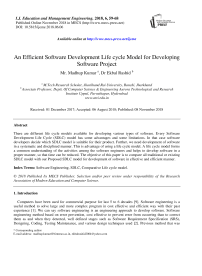An efficient software development life cycle model for developing software project
Автор: Madhup Kumar, Ekbal Rashid
Журнал: International Journal of Education and Management Engineering @ijeme
Статья в выпуске: 6 vol.8, 2018 года.
Бесплатный доступ
There are different life cycle models available for developing various types of software. Every Software Development Life Cycle (SDLC) model has some advantages and some limitations. In that case software developers decide which SDLC model is suitable for their product. Further, we need development of software in a systematic and disciplined manner. This is advantage of using a life cycle model. A life cycle model forms a common understanding of the activities among the software engineers and helps to develop software in a proper manner, so that time can be reduced. The objective of this paper is to compare all traditional or existing SDLC model with our Proposed SDLC model for development of software in effective and efficient manner.
Software Engineering, SDLC, Comparative Life cycle model
Короткий адрес: https://sciup.org/15015788
IDR: 15015788 | DOI: 10.5815/ijeme.2018.06.06
Список литературы An efficient software development life cycle model for developing software project
- Ian Sommerville, "Software Engineering", Addison Wesley, 7th edition, 2004.
- Rajib mall, “Software Engineering princilple” PHI.
- Nabil Mohammed Ali Munassar and A. Govardhan: (2010) A Comparison Between Five Models Of Software Engineering, IJCSI, Vol. 7, Issue 5, ISSN (Online): 1694-0814, pp. 94-101.
- Rajendra Ganpatrao Sabale, Dr. A.R. Dani. (2012): Comparative Study of Prototype Model For Software Engineering with System Development Life Cycle, (IOSRJEN), ISSN: 2250-3021, PP. 21-24.
- Adel Alshamrani and Abdullah Bahattab. (2015): A Comparison between Three SDLC Models Waterfall Model, Spiral Model, and Incremental/Iterative Model, IJCSI, 2015ISSN (Print): 1694-0814 | ISSN (Online): 1694-0784, pp. 106-111.
- Vanshika Rastogi. (2015): Software Development Life Cycle Models-Comparison, Consequences, (IJCSIT), pp. 168-172.
- Aleš ŽIVKOVICˇ, Marjan HERICˇKO, Boštjan BRUMEN, Simon BELOGLAVEC, Ivan ROZMAN.(2005): The Impact of Details in the Class Diagram onsoftware Size Estimation, INFORMATICA, 2005, Vol. 16, No. 2, pp. 295–312.
- Vishwas Massey. (2012): Comparing Various SDLC Models And The New Proposed Model On The Basis Of Available Methodology, IJARCSSE, ISSN: 2277 128X, pp. 170-177.
- T Bhuvaneswari1, S Prabaharan. (2013): A Survey on Software Development Life Cycle Models, IJCSMC, ISSN 2320–088X, pp. 262-267.
- Mark Sherriff and Laurie Williams Defect Density Estimation through Verification and Validation North Carolina State University Raleigh, NC, USA 27695 {mssherri, lawilli3}@ncsu.edu).
- Waman S Jawadekar Software Engineering principles and practice, computer engineering series, third reprint 2006 by Tata McGraw-Hill publishing company limited.
- Stephen H. Kan Metrics and Models in Software Quality Engineering, second edition by Addison Wesley.


